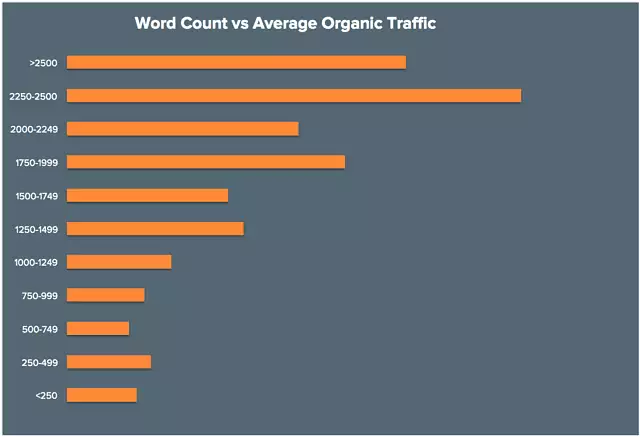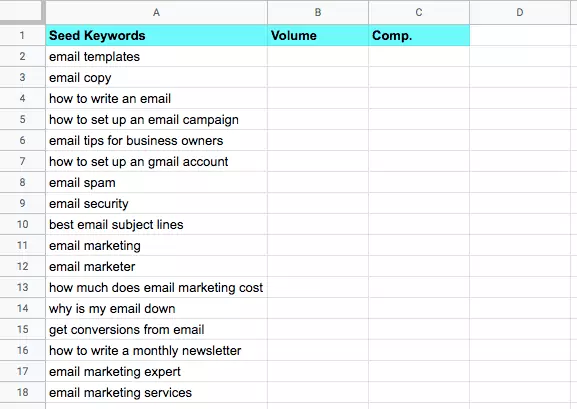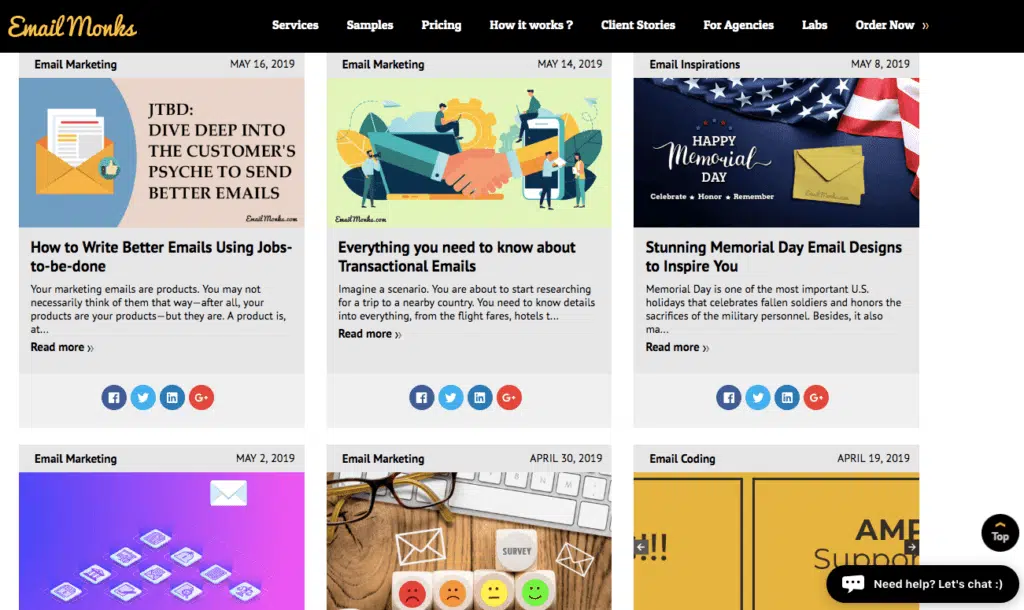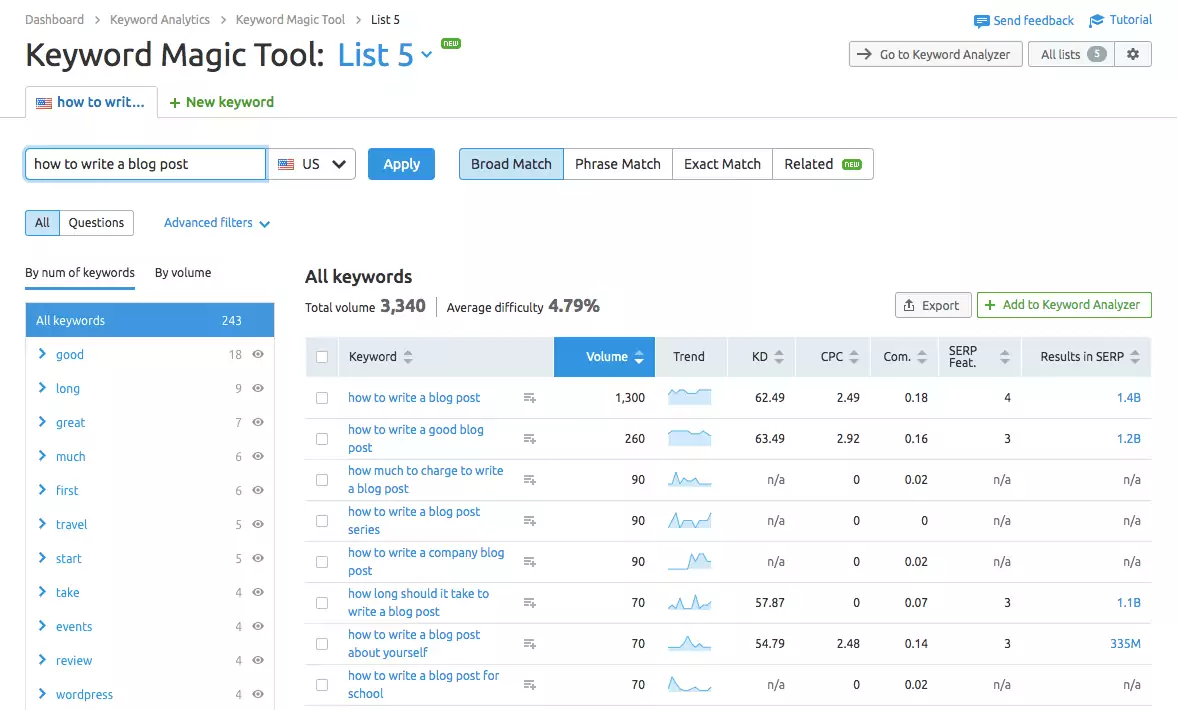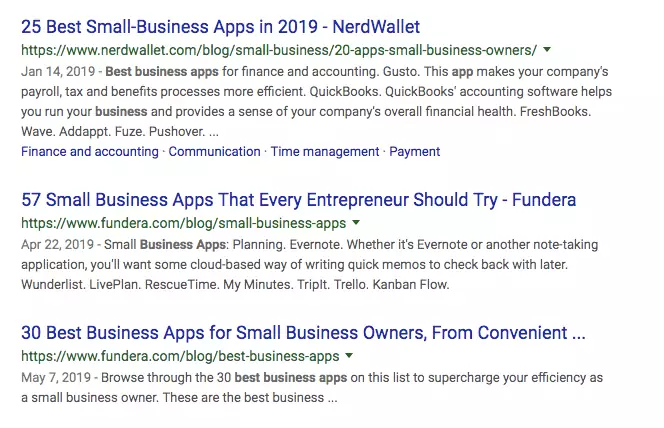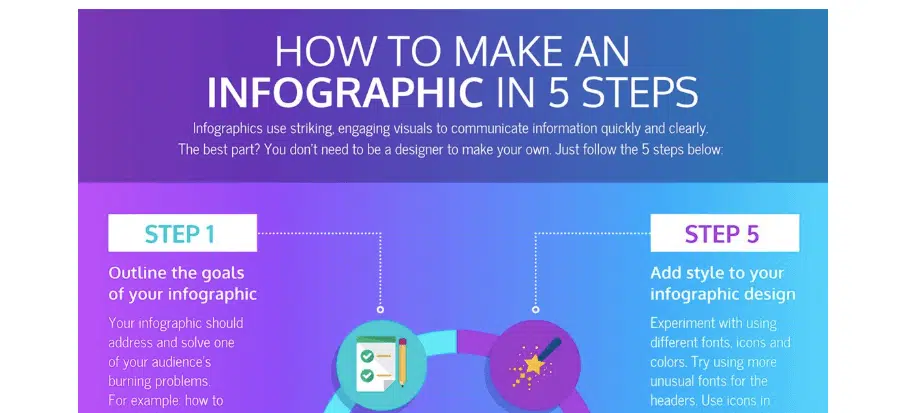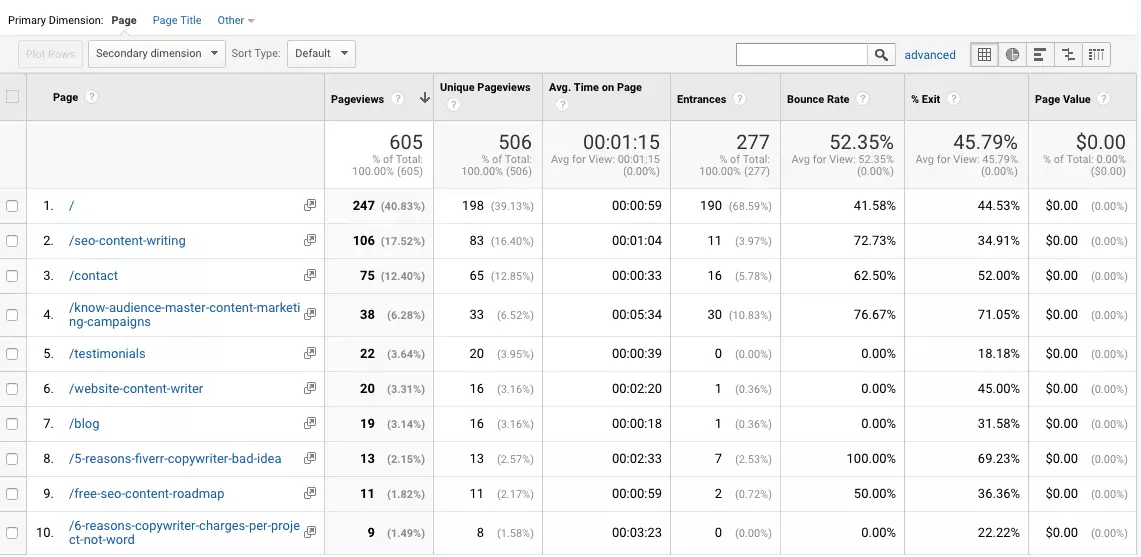“How long should my blog post be?” This is one of the most common questions SEO content strategists get asked and one of the most difficult questions to answer. The simple answer is, “It depends”, but this fails to specify the factors which determine how long your blog post should be for a particular topic. And knowing the “average” just isn’t going to cut it. In this guide, I’ll be revealing which factors to consider when determining your ideal blog post length, plus some statistics that show the effectiveness of long vs short articles for specific types of content.
First thing: Is there such a thing as an “ideal blog post length”?
The above is a common question that’s asked by SEO professionals and bloggers alike. If you want to generate more organic traffic to a website, you, of course, want to make sure your blog posts are up to snuff.
Yet, the answer isn’t as simple as the number of words in a post. (Believe me, I WISH it were that easy).
No, the reality is that the ideal length depends on a variety of factors specific to your website, audience, and SEO strategy.
But before we dive into what’s a good blog post for your site, let’s look at the stats…
Best Length for a Blog Post in 2022– Longer is Better?
There’s an interesting dichotomy that’s occurring in the SEO content space.
On the one hand, SEO pros (including Moz, Hubspot, and Backlinko) are saying that longer is better.
On the other hand, you’ve likely heard the objection, “People have short attention spans! No one wants to read a mile long blog post!”
So which is it? Is there a happy middle ground?
Stats: Long-Form Content vs. Short-Form Content
SEO industry leaders have released countless studies covering the importance of creating engaging, long-form content.
This flies in the face of naysayers who claim users just don’t have the patience for long blog posts. That’s simply not the case… to a point
For instance, Moz published “Content, Shares, and Links: Insights from Analyzing 1 Million Articles”. This revealed a lot of interesting statistics about content length and quality.
The study found that over 85% of online content surpassed the 1000-word mark and that content over 1000 words got more shares than shorter content pieces.
However, this same study also identified a point of “diminishing returns” for content over 2000 words.
Similarly, Backlinko’s study on content length found the average length of top-ranking content to be around 1800 words. Does that make 1800 words the “sweet spot”?
Annoyingly enough, it’s still not that simple.
Hubspot’s study found a few outliers when it came to word count and performance. For articles over 2500 words, organic traffic drops off. But when it comes to backlinks and social shares, content over 2500 words performs best.
So, what’s the deal?
Ideal Blog Post Length – It Depends on Your Goals
While the above studies don’t draw any set conclusions about what the “best blog post length is”, they do lead us to infer a few things:
- That the best blog post length is not set in stone.
- That even the top SEO experts have conflicting ideas on the ideal blog post length.
- That the ideal word count depends on your content goals.
What the studies did establish is that varying lengths of content perform better depending on what you are trying to accomplish.
If the purpose of your content is to up your SEO rankings, that 1800-word sweet spot may be your best bet.
If the purpose is conversions, longer may be better.
And if the primary focus is brand positioning and authority building, the word count may be highly variable.
Now, you may be thinking, “Great. This doesn’t help at all. I just want to know how long my posts should be”.
I feel you. Don’t worry.
I’m about to explain how you can determine the perfect blog post length for YOUR website based on your goals and unique SEO strategy.
When it Comes to SEO Content, Focus on Quality Over Quantity
When writing SEO content, it can be super easy to focus on pleasing the Google gods. It’s a tricky trap to fall into because, of course, you want your content to be SEO-friendly and worthy of generating traffic.
At the same time, though, you risk focusing too much on word count, keyword density, the number of H2 tags, and the like. This can distract you from the primary purpose of your content: to provide value to the reader.
So before determining quantity – i.e. that “ideal” word count for SEO – you need to consider the quality of the content you aim to produce.
Is “Quality” a Science?
As marketing mavens and SEO pros, we love to dig into the numbers. So, the concept of focusing on “quality” sounds a bit woo woo to us. Is quality measurable?
The good news for the left brain in you is YES.
There is a way to determine ideal article length – based on quality – that does involve cold, hard facts.
This process involves:
- Market research
- Goal setting
- Keyword research
- SEO tools
- Competitor analysis
- Data analysis
- Testing
How’s that for using the data to your advantage?
The best news? This entire process involves SEO from the very beginning so you can please Google and users at the same time.
Determining the Best Blog Post Length for YOUR Readers
Let’s put Google aside for a moment.
How do you get inside the heads of your target audience?
How do you KNOW what they want to read and what they are looking for?
If your answer was anything but “Because they told me”, you are likely making a guess. Perhaps an educated guess. But guessing is not data.
With the process below, you’ll be able to figure out EXACTLY what your target audience is looking for, how they are searching for your content online, and, yes, how to determine the best blog post length for SEO for your site.
Step 1: REALLY Know Your Target Audience
If you’ve been making educated (or not-so-educated) guesses when it comes to what your audience wants, worry not. We’ve got something that will help.
Enter: The Only Market Research Survey You’ll Ever Need
Conduct Market Research
The best way to write content that your audience wants to read? Write content that you KNOW they want to read.
With this market research survey, you’ll dig into your audience’s psyche – uncovering their strongest pain points, desires, and fears.
Not only will the survey results tell you what your audience is looking for, but also the intent behind their Google searches. These answers will lay the foundation of your entire content strategy going forward.
Here’s what you need to do:
- Download the free Market Research Survey below
- Send the survey to at least 20 people in your target audience whom you have NOT worked with before
- Tally up the results and circle the top 3 most popular answers for each question
- Make these answers the core of each piece of content you put out
P.S. If you think this is an original concept, it’s not. Countless copywriters use this exact method for conducting audience research. Just see what copywriter Tori Reid has to say about the matter.
Market Research Survey
Download the free survey template Your information will be used to send you this market research survey template and subscribe you to our newsletter filled with tons of SEO content writing tips and goodies. Want off the list? Don’t worry, you can unsubscribe at any time.
Market Research in Action
Here’s how this all plays out…
If, for example, your audience’s top three goals when it comes to marketing are 1) generating leads, 2) building brand authority, and 3) increasing monthly revenue, then each piece of content should be framed around helping them achieve at least one of these goals.
Some post ideas would then be “10 Killer Social Media Strategies to Get You More Leads” or “How to Build Brand Authority with LinkedIn”.
If, at the same time, their top fears are 1) not being profitable, 2) being spread too thin, and 3) not having a big enough marketing budget, some blog post ideas could be “3 Ways to Get More Leads Without Paying for Ads” or “10 Tips for Increasing Your Revenue (without Dipping Into Your Profits)”.
Now, instead of making a guess about what your audience wants, you have the real data to tell you exactly what they want and need. That way, you can create content that is hyper-targeted and appeals to their biggest struggles and deepest desires.
What’s the User’s Intent?
Once you know what your audience wants, you’ll have a better idea about what their intention is when using certain search terms. You’ll also be able to identify new keywords you may have never thought of before.
Using the previous example, let’s assume you are a marketing agency that works with service-based businesses.
If your audience’s #1 goal is to generate leads, they may not be searching for keywords like “how to get traffic” or “how to get more customers”. They may be using keywords like “get more leads” or “best lead gen strategies” or “marketing for lead gen”.
For every keyword you want to target, you’ll need to consider the intention behind the search. What is your audience trying to achieve?
Will content that targets that term deliver what they are looking for? If not, strike it from the list.
Conducting thorough market research and considering intent will allow you to narrow down your SEO keyword list.
You will then use the corresponding keyword data to identify the right blog post length for each topic.
Step 2: Set Your SEO Content Goals
In a broad sense, blog posts are all about providing value to the reader. By providing high-value content, you incentivize Google to rank your content and you incentivize users to click on your content.
The more specific you get about your content goals, the more valuable your content will be.
What is your content goal?
The goal for each piece of content should go beyond just rankings or even traffic.
Likely, you want to entice users to work with you, buy your products, or hand over their email address. Or, you may want to inspire social shares, generate backlinks, or build some authority online.
Determine what your content goal is and stay laser-focused on this goal. What you are trying to achieve in your content will absolutely play a role in how long your blog post should be.
Matching Purpose to Post Length
Determining the ideal blog post length based on the purpose or goal of your content is not a hard science.
However, we do have some statistics to show a correlation between word count and performance of different types of content.
Social Shares – 1000+ Words (Engaging)
As mentioned earlier in this guide, studies have found a correlation between content that’s 1000 words or more and the number of social media shares those posts have received. The primary goal of this content is to be engaging – which typically means being readable without being too lengthy.
Links Building – ~1000 Words (Authoritative)
Likewise, similar studies found that blog posts of around 1000 words received more backlinks than their much shorter and much longer counterparts. Perhaps this is because 1000-word content is often both succinct and valuable.
Rankings – 2000-2600 Words (Competitive)
Multiple sources (here and here) found a sweet spot of 2000-2500 words for better rankings. SerpIQ found that all of the content in the top 10 spots in Google was 2,000 words and over. Other studies saw diminishing returns for content over 2500 words.
However, there were more than a few outliers. In Step 4, we cover how to find the perfect word count range for your articles based on the average word count of the top-ranking content for your focus keyword.
Brand Awareness – Varies (Interactive)
There are no solid studies that have pinpointed a word count range for content that improves brand awareness. Perhaps that is because “brand awareness” is hard to quantify. What we do know, though, is that interactive content takes the cake on this. Adding videos, gifs, images, and other features into the mix will likely do wonders for your brand awareness-driven content strategy.
Conversions – Varies (Trust-Building)
Similarly, word count for conversion-focused blog posts is variable as well. This is likely due to the fact that there are different types of conversions. However, building trust with your audience is the best way to convince them to buy from or work with you. Therefore, you should make blog posts as long as they need to be in order to provide the best value to your audience.
In Step 3, the previous two steps meld together to aid you in conducting thorough keyword research. Driven by what your audience wants and what you want your content to achieve, you’ll be able to find the best keywords to target in your blog posts.
Step 3: Choose the Right SEO Keywords
By this step, you already know what your target audience wants, what they fear, what their goals are, and what they are struggling with. You also may already have a list of keywords that you want to target (if not, no worries).
Now, we fine-tune your keyword list to make sure you are targeting the terms that will reap the greatest rewards.
Create your “seed list”
Depending on where you are at in your SEO content planning process, you may or may not already have a list of keywords that you want to target.
This is what we typically call a “seed list”, as it is your starting off point before fine-tuning your keyword list.
Generate Keywords from Market Research
From your market research you should at least have a list of topics that your target audience is interested in; topics like “generating leads” or “build brand authority” or “reduce business stress”.
Whatever comes to mind, add these to your list.
Generate Keywords Based on the Services/Products You Offer
Obviously you want to draw in users that are interested in your products and/or services. So, be sure to add these terms to your seed list as well. If you offer Facebook ad management, social media management, social media management consulting, and social media graphics creation, make sure each of these have a spot on your list.
Generate Keywords from Customer Questions/Feedback
Have reviews from past clients? Get a lot of questions on social media? If you have this information available to you, you can further generate keywords to add to your seed list based on what your clients or followers are interested in.
Generate Keywords Based on Your Competition
No need to dig into SEO tools to see what your competitors are targeting. Simply scope out their website to see what topics are being covered in their blog. We will fine-tune this list later.
Generate Keywords from Your Imagination
Finally, use your noggin to come up with any other keywords to add to your list. It’s better to add it now and remove it later than to forget about something that could be a great blog post idea.
Fine-Tune Your Keyword List
Having a seed list of keywords is great, but you don’t want to start creating content for them until you fine-tune your list. This is where you identify your strongest keywords based on their search volume, competition level, and the intent behind them.
Use Keyword Research Tools for Search Volume, Competition
First, you want to confirm that your chosen keywords are actually being searched for. Keyword research tools like SEMrush and Keywords Everywhere will show you the “search volume”, indicating how many searches each keyword gets per month.
If a keyword gets 0 searches per month, it may not be worth going after. This is because the time, money, and energy put into creating the content probably won’t pay off if no one is searching for that kind of content. At the same time, going after a keyword with 300,000 searches per month (as an example), may be too competitive, especially if you are just starting out.
Speaking of competition, these same keyword tools will show you how competitive a term is. If you are a new site and don’t have much SEO momentum behind you yet, going after these terms may be a struggle.
Remove any keywords from your list that get no search volume. Also, remove any keywords that are too competitive to go after (at least for now).
Get a 7-day free trial of SEMrush Pro here.
Look for Related Keywords
As you cut your list down, you may actually discover new keywords to add. SEMrush, for instance, will show you keywords related to each seed keyword you type in. If they seem like a good fit for your audience, get search volume, and aren’t too competitive, add them to the list.
Map to the Buyer’s Journey
The last step in fine-tuning your keyword list is to consider the search intent behind them and what kind of content users may expect to find when searching for those terms.
I like to map each keyword to each stage of the Buyer’s Journey: Problem Aware, Solution Aware, and Product Aware. Some may also refer to these as Informational, Commercial, or Transactional keywords, respectively.
For example, keywords like “how to write a blog post”, “what is a keyword”, and “how to set up an instagram account” are likes terms users are searching for when they have a problem and want to find a solution. The content created around these keywords will be informational (versus covering a specific brand or trying to sell a product).
At the same time, keywords like “where to buy snow boots” or “best gps tracking device” are more commercial and align with someone who is looking to buy something and wants to weigh their options. Keywords like “buy [brand] snow boots” or “gps tracking device deals” indicate an intent to buy as soon as the user finds the right price.
You will want your list of keywords to contain keywords from all different stages for all different content types.
Now, you should have a rock-solid list of keywords worth going after in your blog posts. So, now it’s time to figure out how long those blog posts should be.
Step 4: Determine Blog Post Length Using SEO Tools & This Method
One way to determine a baseline word count for your blog post for each keyword is to use an SEO content tool. Our favorite is the Surfer SEO app.
This is a paid tool that allows you to enter any target keyword (for any country) and generate a wealth of data regarding the top-ranking content for that keyword. Including the word count.
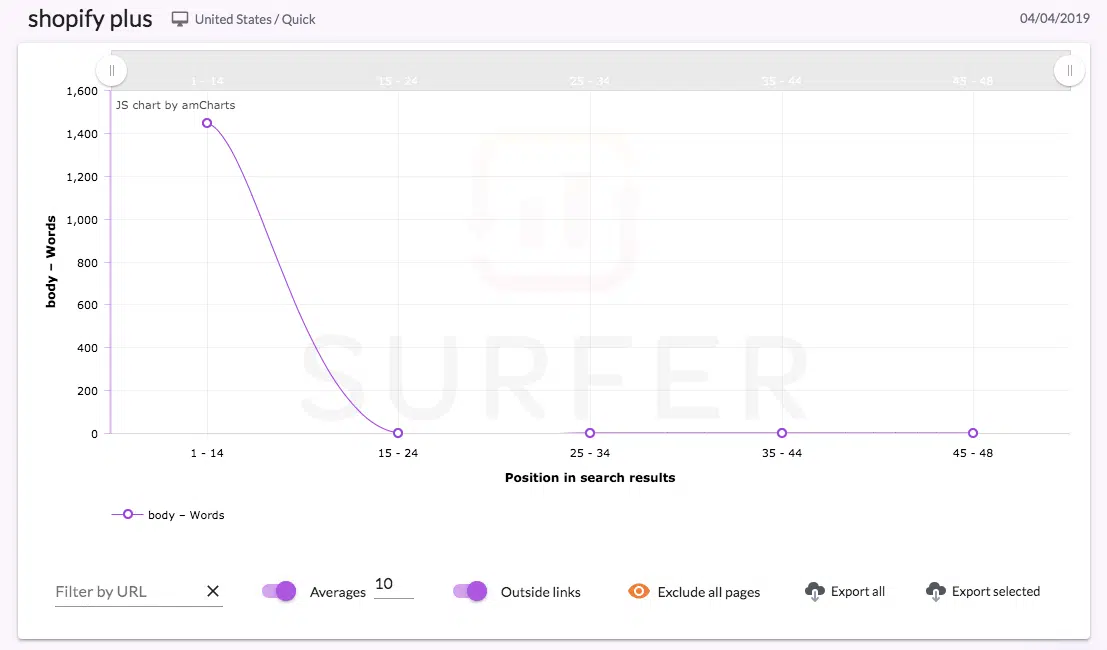
In the above image, you see that I searched for “shopify plus” and Surfer generated a graph of the average word count for the top ranking content. In this case, the average word count of the content between positions 1-14 is around 1,400 words.
Although not a hard rule, this gives us an idea of about how long our content piece should be. And in order to outrank the top blog posts, we probably want to go a bit longer than that – maybe 1500-1600 words.
Alternate Method
Now, not everyone has the means to invest in a bunch of SEO tools. If you are strapped for cash, you can simply calculate the average word count on your own.
- Open up a new Google Doc, or use your favorite word count tool.
- Copy and paste the content from the top-ranking website for your focus keyword.
- Record the word count.
- Repeat for each website at position 2-10.
- Add up all the word count numbers (ex. 1500 + 1325 + 750, and so forth) and divide by 10. This will give you the average word count.
Again, this gives you a rough idea of how long your blog post should be.
Note: Neither of these methods is exact. Some pieces of content in the top ranking spots may be posts and others may be pages. You may want to make your content longer or shorter, based on what makes sense and will provide the most value to your audience. Consider the reader first.
Step 5: Provide “3X the Value”
While the “3X the value” rule gets thrown around a lot when it comes to SEO content, like everything else, it’s not a hard rule. However, the general idea is that your blog post should be three times as good as whatever is already ranking.
This makes sense, as Google has no incentive to rank your content if it is worse than what’s already ranking.
By providing more value, you have a better chance of climbing to the top.
Longer Isn’t Necessarily “More Value”
More content isn’t necessarily more value, but it could be. You will have to decide if adding more words to the page is actually adding more value. Ultimately, your reader decides if this pays off, so it’s not worth it to just throw more words in for no reason.
Ways to Add Value
Rather than just adding words to your blog posts, you may want to consider these other ways to add value:
- Introduce new concepts that your competitors haven’t mentioned before
- Add an infographic or other custom graphics
- Create a video to go along with the blog post
- Add a “Frequently Asked Questions” section
- Make your blog format more readable (shorter sentences, more bullet points, etc.)
- Add fun GIFs
- Include block quotes from relevant experts
- Embed a quiz or calculator to make content interactive
There are many ways to make your blog posts 3X more valuable than what’s already ranking. This is the surest way to outrank the competition. Blog post length is only one part of the equation.
Step 6: Test, Measure & Analyze!
No matter how much data we think we have, we never really have all of the answers until we test out our strategy.
You can follow all the best practices in the steps above, but in order to know what works, you need to measure the results.
Measure Results in Google Analytics
Continue creating content and track your progress using Google Analytics. See which posts get the most organic traffic. If you want to get fancy, you can set up conversion tracking to see which posts generate the most conversions.
Things to look for:
- Which posts are getting the most organic traffic?
- What is the average word count of the posts that are getting the most traffic?
- Which blog posts are converting the best? What is the average word count of those?
- Which blog posts are getting the highest bounce rate? Any similarities between these posts?
After 3-6 months of posting on a regular basis, you should have data to show what is working and what isn’t. Every website is different, so don’t get discouraged if yours takes longer to show results. Eventually, it will.
Repeat What’s Working, Fix What Isn’t
Once you have this data, then it’s just a matter of repeating what you’re doing right and fixing what you’re doing wrong. You can apply any trends you see to your future blog posts.
It may be helpful to keep a log of any similarities that you see between your best-performing blog posts so you can refer to it when you are creating new content.
How Long Should a Blog Post Be? You Tell Me!
While determining the ideal blog post length is not a hard science, there is a data-driven way to figure out what’s best for YOUR site and audience.
When you know what your audience wants, have the keyword data to support it, and compare those topics to what’s already ranking in the search engines, then you can get a pretty good idea of how long your blog posts should be.
Don’t forget to apply what you’ve learned in this guide, measure the results, and repeat what works. That is the best way to come up with an SEO blog post strategy that’s the perfect fit for your website.
Have questions about figuring out the perfect blog post length? Let us know in the comments.



